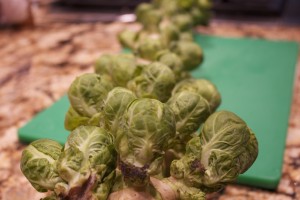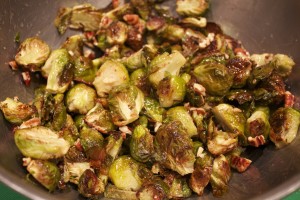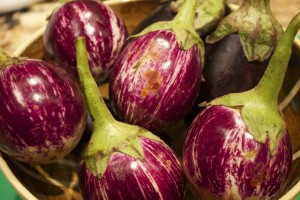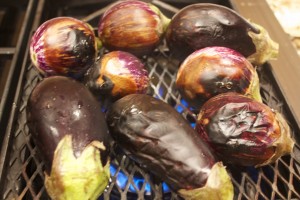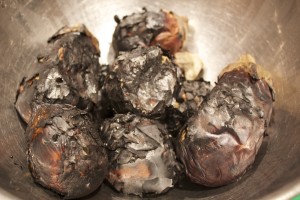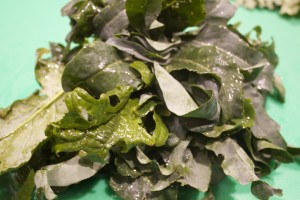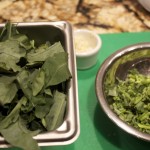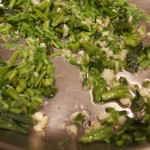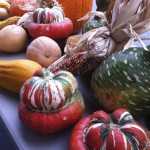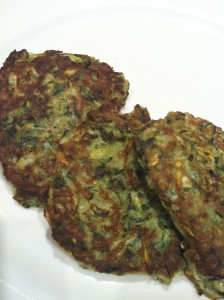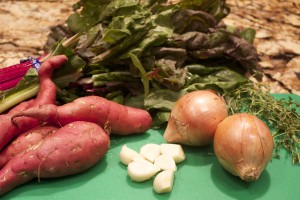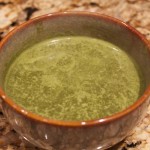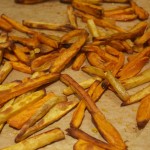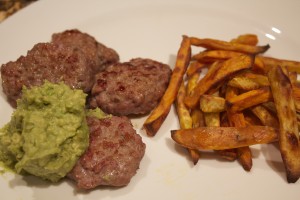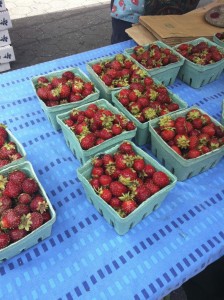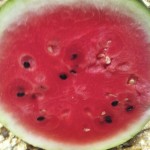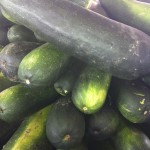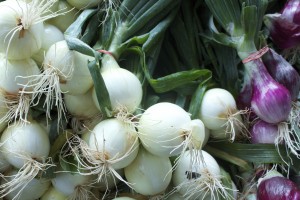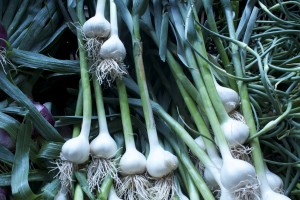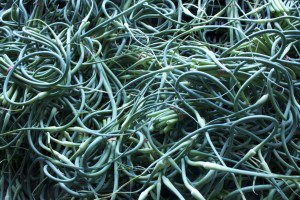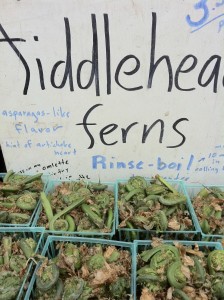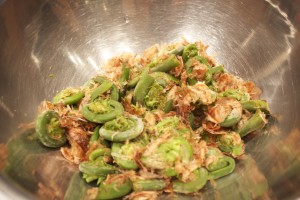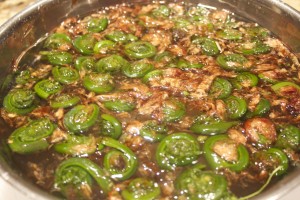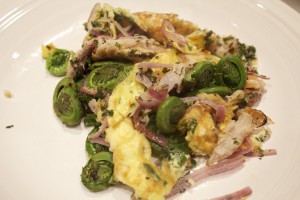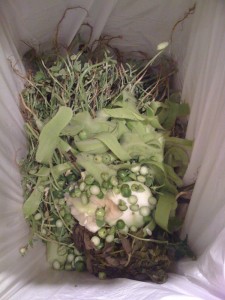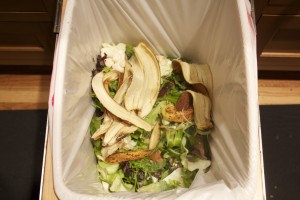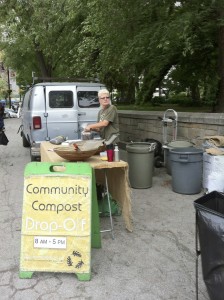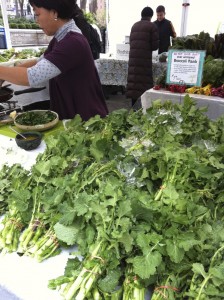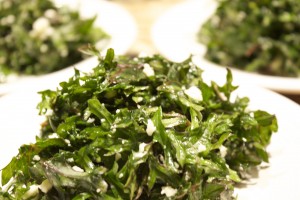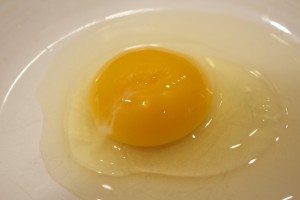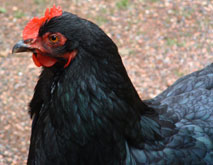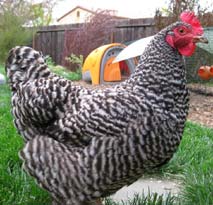
|
Seasonal Vegetable Dishes from Union Square Greenmarket Last week was beautiful at the Union Square greenmarket. The whole stalks of Brussel Sprouts were too enticing to resist, so I bought a whole stalk. I’m not the only ones enamored with snapping off the the nuggets from the stalk. Over the weekend, the little nephews had a wonderful time snapping off the sprouts as well. I halved the stalks, tossed them with extra virgin olive oil and salt, and roasted them at 375˚ for 20 minutes. Meanwhile, I made a quick glaze of maple syrup, mustard, and butter that I heated on the stove. I tossed the Brussels sprouts with this mix and sprinkled the whole lot with chopped pecans. It’s nearing the end of eggplant season as well, so I purchased these miniature varieties and roasted them on the my chile grate (these grates are wonderful for roasting multiple vegetables at once.) I like the chile grate especially for small chiles and eggplants, since they don’t fall into the open flame. The smokey flavor of eggplants cooked directly over the fire is irresistible. After I covered them and let them cool a bit, I scraped off the skin, chopped the flesh, and mixed them with tahini, lemon juice, garlic, parsley, and pomegranate molasses. I served the chunky dip on rye bread from Rui’s, a fairly new Friday and Saturday Union Square Greenmarket addition. These guys make traditional hearty, delicious Scandinavian (100 per cent) rye bread. I also picked up an interesting vegetable called spigariella. It actually is a kind of broccoli without florettes, and tastes like a sweeter version of broccoli raab. It cooks in just minutes. I cut off the stems and cooked them first with garlic, olive oil, and red pepper flakes.
Share on Facebook and Twitter | Greenmarket Bits, Greens, ingredients, Side Dishes, Vegetables | No comments
Getting the Water out of a Zucchini I’m on a market watch – greenmarket watch that is. Several times a week, I walk through my neighborhood farmer’s market and survey the new arrivals and take notice of what is no longer available. This journey is how I keep up with the changes in seasonal produce, and it’s how I stay inspired in my cooking. In early summer, local markets are brimming with delicious produce; even an average supermarket has a broader than usual selection of colorful vegetables and fruits. It’s still worth going out of your way to a venue where you can speak to the growers. The abundance and variety of eatables, the enthusiasm of the farmers, and the excitement of happy people shopping prompt me to load up my cart with local delights, and pile my dinner plate with a variety of fresh vegetables.
In a farmer’s market from July though October, besides the green zucchini, you can purchase the bright daffodil-yellow ones as well. Summer squash come in a wide variety of shapes and sizes – from round eight balls to yellow- and-green zephyr squashes, ruffle-edged patty pans to ridged romanescos. Even though summer squashes come in a variety of shapes and sizes, you can use them interchangeably in recipes. All varieties tend to be watery. If you want to coax the most flavor out of summer squashes, it’s best to get rid of a lot of that water. After all, few delight in a soggy squash dish. I use salt to extract the excess moisture. To sauté a pound of sliced zucchini, sprinkle about a teaspoon of salt over the pieces and let them rest for 20 minutes to half an hour. You’ll notice the zucchini start to sweat and glisten. Wipe off the surface moisture with a paper towel – which gets rid of the excess salt – and now you’re ready to sauté. Your slices will caramelize beautifully, leaving a golden color and rich flavor. The salting technique is especially effective with grated zucchini. For each pound, mix in 1 teaspoon salt. After about twenty minutes, grab a handful at a time of the grated vegetable and start squeezing – over a bowl, of course. I’m always amazed at just how much water comes pouring out. After you’ve gone through the first round, go back and squeeze the whole lot one more time. Again, any excess salt gets squeezed out with the water, and your grated zucchini is ready to be turned into delicious pancakes, fritatas, or whatever else you’re cooking. Share on Facebook and Twitter | Greenmarket Bits, Kitchen Tips, Vegetables | No comments
Night Before Irene We were among the lucky to have been in Manhattan during hurricane Irene. Still, we didn’t know how hard the storm would hit, but we did know the city would shut down public transportation as of noon on Saturday. It seemed wisest to stock up with eatables. Everyone seemed of the same mindset; the markets on Friday afternoon were teeming, and rumors circulated at Union Square that the greenmarket would be closed on Saturday. Half of the farmers did show up, however, and they did brisk business. Hats off to those intrepid farmers. It was a good weekend to attend to some home projects without the guilt of feeling I should be out and about. I wanted our food to be quick and comforting – and, of course, delicious and nutritious. The menu: Purée of Swiss Chard soup, roasted sweet potato fingers, and turkey sausage with avocado mustard. Purée of sweet potato soup: I sweated a couple cups onions in olive oil, then added half a dozen peeled whole garlic cloves, a dime’s thickness of fresh thyme springs, a couple of peeled fingerling potatoes, teaspoon salt and a quart of chicken stock that I had from one of my favorite greenmarket purveyors (Garden of Spice, which are at the Union Square on Wednesdays). I let the soup simmer partially covered beautiful chard (stemmed) and let it wilt in the hot soup for a couple of minutes. I blended the soup, put it back in the pot, added a squeeze of lemon, a sprinkling black pepper, and adjusted the salt. Meanwhile, I roasted these sweet potatoes (mix of white and orange) in virgin coconut oil and salt. Coconut oil gives the sweet potatoes a delicious buttery flavor. I smashed an avocado with a dollop of Dijon mustard and cooked up sweet turkey sausage from Di Paulo farms. The sausage is beautifully spiced and ready to cook. Everyone loves it! http://brooklynbased.net/email/2010/11/where-to-get-your-gobble-gobble/. (This link has a description of the poultry farmers at Union Square. Not all have websites. The link also includes some purveyors that ship pasture-raised poultry.) It was a casual and satisfying meal on the eve of an impending storm. Share on Facebook and Twitter | Dinner, Greenmarket Bits, Recipes, Where To Buy (Sources) | No comments
August Report from the Union Square Greenmarket Saturday was my first day back at Union Square greenmarket after a period of traveling. I had to restrain myself from buying everything in sight. Here’s some notes and a record of what I made from my purchases: These late New York season strawberries were irresistible – super sweet, the best strawberries of the year. I was thrilled to see piles of watermelons. It’s melon season, of course. A note to purchasing just the right ripe melon: Please make sure to knock on the melon, as if you were knocking on someone’s door. If it’s ripe and sweet, it will sound hollow. I scored with this one.
The extra went into these popsicle molds.
The sight of these elephant-sized zucchini stopped me in my tracks. I was assured that once the seedy middle was cut out, the remaining part would be sweet. While I am intrigued by the thought of stuffing one of these, I refrained from purchasing them . Instead I came home with a large bunch basil, some yellow and green zucchini, a few ears of corn, and a couple of racks of lamb riblets. When I got home, I picked the leaves off of the basil and pureed it with extra virgin olive oil to keep it fresh. I knew I had little time to make dinner today, but nonetheless I wanted a delicious meal. I got home in the late afternoon, and had a lot to do besides make dinner. I decided to construct a meal that would cook slowly (lamb riblets take over 2 hours) but would require minimal active time. I had defrosted the lamb riblets overnight in the refrigerator. I had some barbecue spice rub (from The Healthy Hedonist, which consisted of a mix of salt, maple sugar, cumin, chili powder, black pepper, cayenne, and paprika) in a little container, so rubbing the mix on the riblets and placing them in the oven on a parchment-covered baking sheet took only a matter of minutes. An hour later, I turned down the heat from 325˚to 225˚. An hour after that (by this time it was 6:45) I started the rest of the dinner. I grated the zucchini (one yellow and one green) and mixed it in a bowl with ½ teaspoon salt. I let it sit for fifteen minutes. Meanwhile, I filled a medium pot with water, placed it on the stove, and husked the corn. Fifteen minutes later, I cranked up the heat on the burner under the pot. I squeezed the water out of the zucchini, and placed it back in the bowl, and mixed it with a couple of tablespoons unbleached white flour, a scoop of the basil puree made the day before, and one egg. I dropped the corn in the boiling water and a tablespoon or so of coconut oil to heat in a large non-stick skillet. I dolloped spoonfuls of pancake batter into the skillet (two zucchini yielded 7 medium- sized) and cooked the pancakes for 2 to 3 minutes per side, until golden.
Share on Facebook and Twitter | Dinner, Fruit, Greenmarket Bits, Kitchen Tips, Main course | No comments
The Onion Family The onion, or lily family, is characterized by strong tastes and sulfurous odors, and includes onions, leeks, scallions, garlic, chives, and shallots. Known as alliums, these universally used vegetables have abundant health benefits. They are antioxidants, anti-inflammatory, antibiotic, and antiviral. They help remove parasites and heavy metals from the body. They contain Vitamin A, B-Complex, and C. How the alliums are cooked influences how pungent they are. Garlic cooked whole is only sightly pungent, and sweet nutty notes come to the front. If onions and garlic are pickled, they are relatively mild. Long, slow cooked onions become sweet. The sulfur product, which causes our eyes to water, is produced in significant quantities only in the onions, shallot, leek, and chive, most especially in onions. To avoid crying, you can pre-chill an onion for 30 to 60 minutes in ice water. It hydrates the papery onion skin, which makes it tougher and less brittle, and easier to peel off. Chopped alliums to be eaten raw are best rinsed to remove irritating strong smelling sulfurous molecules. Soak a sliced raw red onion in cold water for fifteen minutes, for example, before adding to your salad. Here are some things to know about some of the most common varieties in the lily family. Onions fall into two major categories: Spring onions are planted as seedings in the late fall and harvested before maturity following the spring and early summer. You see them in green markets with the green shoots coming out of them. They do not have brown papery skin hiding the bulbs. They are moist, relatively mild, and perishable; and are best kept in the refrigerator. The second category is the globe storage onion, the most common type, available all year. They are grown in the summer and harvested when mature in the fall, and are rich in sulfur compounds. Look for firm onions with papery dry skin, not beginning to sprout. These are best stored in a dry, well ventilated place, not near potatoes, and not refrigerated. White onions are milder and moister than yellow, and don’t keep as well. Small and medium onions are more pungent than large, which are sweeter. Red onions are also sweeter and milder than the globe, are favored in pickles and condiments, and store for two to four weeks. When red onions are cooked, the color is diluted. A little acid, like lemon or vinegar, brings the color back.
Scallions can be either bulb forming onion varieties or green onions harvested quite young, or special varieties that never form bulbs. Chives look like a slender scallion without the white bulb and are more delicately flavored. They are most often eaten as a garnish or in subtly flavored dishes. Shallots are a distinct clustering variety of onion, often with a purple coloration, whose bulbs are smaller, finer-textured, and somewhat milder and sweeter. Leeks are grown for a scallion-like mass of fresh leaves. They are a sweet cousin of the onion, and are milder than onions and garlic. The white part is most often used, and smaller leeks are more tender and flavorful than large. Larger ones often have a lot of grit in the leaves, so it is easiest to submerge the cut pieces in water after cutting to clean them. Garlic stimulates the metabolism, and it is known as an antibacterial, anti-carcinogenic, and anti-fungal. It stabilizes blood sugar level, lowers fever by increasing perspiration, promotes healthy intestinal flora, and is good for blood pressure and lowering cholesterol. To peel garlic easily, place a clove of garlic on a hard surface – use the flat side of a knife, then give it a quick whack to crush it. Cut off the root end and the skin peels away easily. Garlic Scapes are essentially young garlic shoots. They have a mild garlicky flavor, and they are delicious when chopped into small pieces to flavor a cooked dish or summer salad. Alternatively, use them for a high drama garnish. Share on Facebook and Twitter | Greenmarket Bits, ingredients | No comments
Fiddlehead Ferns Last week I noticed the first fiddlehead ferns at the Union Square greenmarket. I couldn’t resist purchasing them. Fiddleheads epitomize spring at its most fleeting – they are available a mere three to four weeks locally. If you want to play with these furled fronds, get them soon; consider a visit to a local market at least in the next two weeks, or you’ll be too late and will have to wait until next year. The ferns actually started showing up in Whole Foods a few weeks earlier than they did at the greenmarket; the ones at Whole Foods are are probably imported from Maine, since those have a bit of a longer season, lasting from April through May. Fiddleheads are from the Ostrich fern, and have a brown papery scaly covering (they remind me of bonito flakes) the uncoiled fern. The ostrich fern is a wild food found in wet areas: on the banks of river, steams, and brooks. Their flavor is a cross between that of asparagus and artichoke. For my preparation, I soaked these in water to dislodge the papery coverings. Honestly, I never did see ferns with the coverings before this year, and I’ve been cooking these delicate scrolls for years. The coverings made these specimens seem fresher and just-foraged. Make sure to pick off any papery bits that don’t dislodge in the water (this job is a bit “fiddly”), then steam or boil the ferns before cooking or dressing further. I paired these babies with smoked mackerel, sautéed red onions and slivered ramps for a delicious breakfast this week. Viva la primavera! Share on Facebook and Twitter | Breakfast, Greenmarket Bits, ingredients, Vegetables | No comments
Beautiful Compost Since I live so close to Union Square, I feel an obligation to collect my kitchen scraps and bring them over to the compost bins that are there every day the greenmarket is open: Monday, Wednesday, Friday, and Saturday. I keep my vegetable peelings in a separate garbage pail; as you can well imagine, with the amount of cooking that I do, the bag fills up rapidly. “Send it to the worms!” is what we say in this household when we pitch something to the compost pile. The heap can sometimes appear quite beautiful, arranged like a composed salad, or a collage. Usually it’s more pedestrian looking, like this: The big pain is remembering to haul that bag over to the market at least once a week to prevent rotting; twice a week is even better. One would think this would not be difficult, considering I go to the greenmarket almost every day it’s there. Nonetheless, I have done my share of grumbling over this simple task; at times it feels like another dreary chore. All that changed two months ago – the morning that I locked myself out of my home. I had just wheeled my cart with a full-to-capacity bag of scraps into the elevator. Just as the doors were closing, I realized that I had left my handbag inside. There I was — no phone, no keys, not even one penny. Luckily, my husband was home, but I needed to call him; I combed my mind to figure out what phone in the neighborhood I could borrow. It seemed like a good idea to get rid of the bag of vegetable leavings first, so my first stop was at the greenmarket. On the way there, I remembered the compost lady. Of course she would certainly lend me her phone. I’m a regular, and she knows me well enough. Aurelia (I didn’t know the compost lady’s name before then) was more than gracious, even though I did hijack her phone for a full twenty minutes before getting through to my husband. (Blame it on the shower.) Interestingly, my attitude changed after that experience. I stopped grumbling, and now I almost even enjoy unloading my bag there. I invariably exchange a few amicable words with Aurelia; I am eternally grateful to her for helping me out of a pickle. The folks from the Lower East Side Ecology Center used to pick up the juice bar pulp back in the 1990’s, when I was cooking at Angelika Kitchen. They no longer collect restaurant scraps, because they get so much good raw material from all of us individuals. By the way, their potting soil is excellent. The Lower East Side Ecology Center is truly one of New York City’s gems. Their mission statement: Outstanding Renewal Enterprise, Inc. (The Lower East Side Ecology Center) was founded in 1987 as one of the first organizations to offer community-based recycling and composting programs in New York City. We started our programs by providing innovative recycling drop-off centers. Today, the Ecology Center offers free public compost collection and education, electronic waste recycling, stewardship of public open space, and environmental education. Our programs focus on offering opportunities for all New Yorkers to learn about environmental issues facing NYC and to take responsibility for solving those problems. http://www.lesecologycenter.org/ Share on Facebook and Twitter | Greenmarket Bits, Musings | No comments
“Wintered-Over” Greens from the Union Square Greenmarket Today, as I walked by the Bodhitree farm stall, on the Northwest side of Union Square market, I was immediately attracted by a big beautiful pile of broccoli rabe sitting on a table in front of the booth. Up until now, in late March and early April, I have refrained from buying at the market the greenhouse greens. I don’t get that excited about greenhouse greens, which to me is like trying to force in Spring a little too early. I like to wait until greens come out of the ground, which is a sure sign that spring has truly arrived. This particular pile of broccoli rabe did come out of the ground. They are what is known as “wintered over” greens. Nevia No, formally the owner of Yuno’s, who now has rented 70 acres in Burlinton County, New Jersey, enthusiastically explained what “wintered over” greens are. “We cover the greens with a kind of tarp for the winter until there’s no more sign of frost. We then uncover them. The roots are still in the ground, so that the first greens that come up are really sweet.” Thus, the first broccoli rabe of the season is barely bitter, unlike the broccoli rabe that grows in the warmer months. I was inspired to purchase a head, which I plan on cooking tomorrow. Next, it was an exotic pile of Russian Kale that drew my attention. I’m not talking about the decorative Red Russian kale that is used for winter garden borders. This is a spindly-leaf variety that I had never seen before, and I think of myself as a kale veteran. I’ve used curly kale and dinosaur kale (a.k.a. Lacinato, Italian, or black kale ) in a multitude of different preparations. This new variety was a thrilling discovery. Since the Russian kale was wintered over as well, and reportedly quite sweet, I was even more interested. When No waxed enthusiastically on how good it even was used raw in salads, I was sold. The first thing I did to the kale when I returned home was pull the leaves off the thick stems. I then tore them into bite-sized pieces and washed them. I transferred the leaves to a bowl where I massaged a simple olive oil-lemon-garlic vinaigrette into the leaves along with some salt. It sounds strange to massage a salad, but you really don’t have to go too crazy. You simply rub the leaves for a few minutes until you can feel them soften. I then tossed the salad with a little sheep’s milk feta cheese. It was quick and simple as can be, but the results were delicious. One head served a decent portion for three. Since these “wintered over” treasures are only going to be available at the market for another 10 days or so, I suggest making a stop at the market and trying some. Bodhitree Farm is at the Union Square Greenmarket Wednesdays and Fridays. Share on Facebook and Twitter | Greenmarket Bits, Greens, Recipes | No comments
Grazin’ Angus Acres Eggs From the Union Square Green Market If you want eggs from chickens that are truly roaming around outside, you have to go for what is called “pastured” eggs. These are the types of eggs that one usually finds when buying at a greenmarket, farm, or community buying club. Pastured chickens are free to roam, peck, and wander around in the fresh air. They eat supplementary feed to round out their diet of foraged bugs, worms, and fly larvae. Pastured eggs have beautiful orange yolks, which stand up proudly on top of the glossy whites. Pastured eggs are loaded with Omega 3’s and beta carotenes. They taste immeasurably better and have more vital energy than a supermarket egg, even the organic variety. I’ve never heard of a pastured egg from a well-treated healthy chicken containing salmonella. It’s a given for me that these eggs are definitely worth seeking out. That being said, even at Union Square there’s quite a selection of eggs to choose from, and a price range that goes from 4 to 8 dollars a dozen. I wanted to find out why this was so. To satisfy my curiosity, I spoke at length two days ago to the farmer manning the booth at Grazin’ Angus Acres. I asked him why his eggs were so much more expensive than everyone’s at the market. What I got was an interesting earful of details about his farming methods. Grazin’ Angus Acres 450 acre farm, located in Ghent, New York, is for grass fed and finished Black Angus beef. They also have pasture raised chickens for eggs. During the summer months they also raise chickens for meat. The owner Dan Gibson says “it’s all about the grass.” He works an additional couple thousand acres where he raises grasses and hay to feed the cattle and chicken throughout the winter. Dan proudly displays pictures of his egg mobiles and his happy chickens roaming on the grass. The farmer at the booth told me that one of the reason Dan’s eggs are so expensive is that he keeps his chicken on pasture the entire year. The grasses he grows for the winter are also expensive. The supplemental feed that he purchases for them is organic, grown by a local farmer. (I had heard before from other farmers that what usually drives up the price of eggs is the use of organic supplemental feed.) The feed currently includes organic corn and soy, but they are working on developing a feed that does not contain soy. Dan Gibson’s egg mobiles are quaint-looking old hay rig tractor gear that he built with local lumber. The chicken are ushered into the egg mobiles every night to protect them from predators. The chickens and cattle on the farm have a symbiotic relationship around the cultivated grasses. At Grazin’ Angus Acres they have four kinds of grasses, including high sugar carbohydrate rye grasses and two broad leaf clovers – all of which fix nitrogen out of the air and bring it into the soil. The fertile soil feeds the grasses which feeds the cows and chickens. The folks at Grazin Acres manage the grazing carefully. They corral the cows into a designated area for a 24 hour period, where the cows eat most of the grass and trample the rest. They leave behind their organic material. The chickens are brought in about three days later, just as the fly larvae are about to emerge. The chickens scratch the patties apart, eat the larvae (which cut down on the number of flies on the farm), and spread the manure. There’s no need for a tractor or fossil fuel. Chicken manure is apparently the best organic fertilizer known to man. It helps the grass grow, which helps the cows grow, which helps the chickens. The relationship is perfectly symbiotic. Of his 400 hens, 200 are Black Australorp and 200 are Barred Plymouth Rocks. The average hen lays 6 eggs a week, which comes to about 10 dozen a day. Grazin’ Angus Acres are at the Union Square green market Friday and Saturday. They are at Carroll Gardens and The Natural History Museum on Sundays. Share on Facebook and Twitter | Eggs, Greenmarket Bits, ingredients, Where To Buy (Sources) | No comments
Welcome to Myra’s Kitchen blog Welcome to Myra’s Kitchen blog. Check in for frequent posts that will include cooking tips and greenmarket ingredients; notes on favorite products; commentary on books and articles; and health tips and musings. We’d love to hear from you, so please e-mail us with comments or queries. Share on Facebook and Twitter | Books, Greenmarket Bits, Happenings/Events, ingredients, Kitchen Items/Gadgets, Kitchen Tips, Musings | No comments
|
